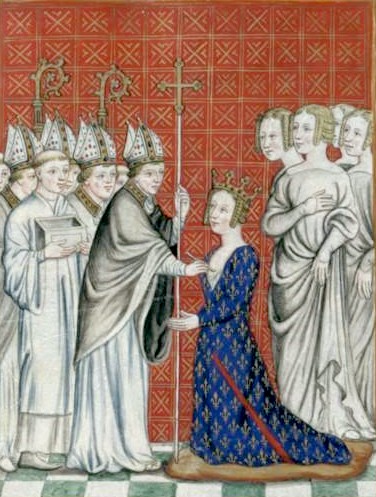Queen Jeanne de Bourbon was a cousin-wife to King Charles V of France known as the Wise (le Sage). Jeanne was born on the 3rd of February 1338 at Château de Vincennes, in the town of Vincennes, to Pierre I de Bourbon, Duke de Bourbon, and Isabella de Valois, Princess of France, who was a half-sister of King Philippe VI of France called the Fortunate (le Fortuné). On Jeanne’s paternal Bourbon side, she was a direct descendant of Count Robert de Clermont, who was a French prince of the blood (prince du sang) and the youngest son of King Louis IX of France known as Saint Louis and his consort, Queen Marguerite de Provence.
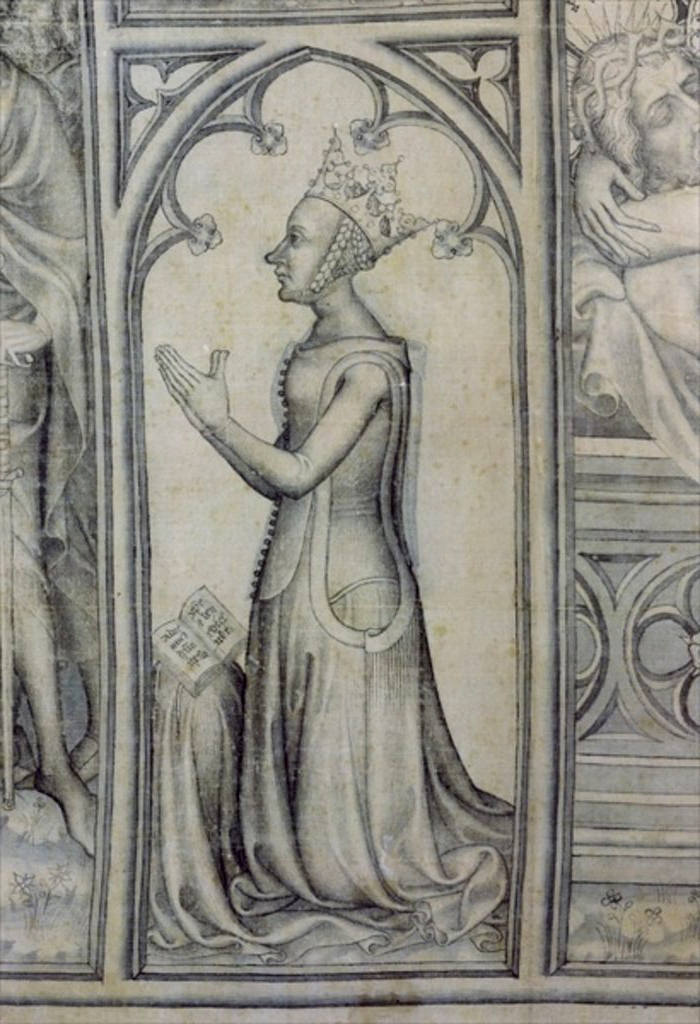
On the edge of the Bois de Vincennes, the castle of Vincennes is the largest royal fortified castle in France that tells a rich story full of unexpected twists and turns in the country’s history. As a wife of a prince of the blood, Isabella de Valois spent quite a lot of time at the Valois court of her brother, Philippe VI, and later that of her nephew – King Jean II of France called the Good (le Bon). Moreover, Jeanne’s father – Duke Pierre de Bourbon – held the high office of Grand Chamberlain of France, so he always lived at the royal court.
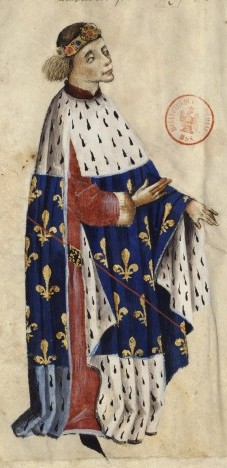
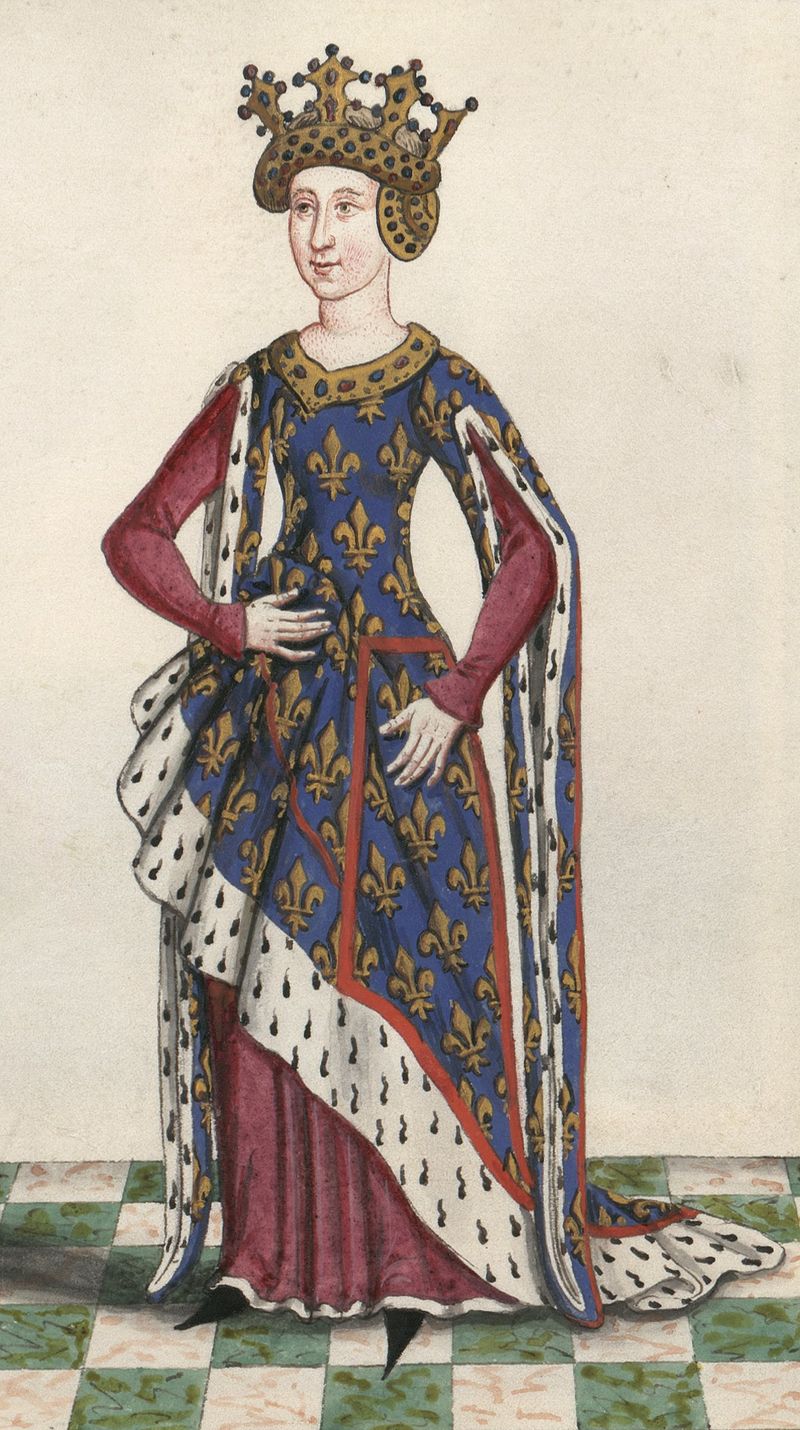
The girl’s parents had a large progeny. Jeanne’s elder brother – Louis II, Duke de Bourbon – would years later have a place on the Regency Council during the minority of Jeanne’s elder son – King Charles VI of France. Jeanne’s sister, Blanche de Bourbon, would enter into matrimony with King Pedro of Castile, but she would be killed by him in 1361. Jeanne’s sisters Bonne and Catherine de Bourbon would marry Amadeus VI de Savoy and Jean VI d’Harcourt, respectively. Jeanne’s sister Marguerite de Bourbon would become the wife of Arnaud Amanieu, Lord of Albret, by whom she would have a son – Charles d’Albret, future Constable of France.

In childhood, Jeanne was supposed to marry Amadeus VI, Count de Savoy, and negotiations for their wedding were conducted between 1340 and 1343/44. Their union was considered quite important to bring Savoy more closely into French influence, but it did not happen. Jeanne was then engaged to Humbert II de la Tour-du-Pin, Dauphin of Viennois, but this betrothal also fell through. Soon Jeanne was betrothed to her 2nd cousin, Dauphin Charles ( future Charles V of France, – at Tain-l’Hermitage, and their parents had to apply for a papal dispensation for them because of their close blood relationship.
Jeanne and Dauphin Charles got married on the 8th of April 1350. Born thirteen days apart, at the time they were both 12 years old. In 1355, Jeanne was made Duchess of Normandy together with her husband. Both Jeanne and Charles lost their fathers during the catastrophic defeat at the Battle of Poitiers of 1356: the Duke de Bourbon perished on the battlefield, while King Jean II was captured by the English. In the early summer of 1358, Jeanne with her retinue was besieged at the Meaux fortress, situated on the Marne River, by rebellious peasants known as the “Jacques” and the Parisian partisans of Etienne Marcel. She was rescued by the forces of Dauphin Charles, who soon suppressed the revolt now popularly called Jacquerie.
When Charles inherited the crown in 1364, Jeanne became Queen of France. In May 1364, she and her husband were crowned by the Archbishop of Reims Jean de Craon at Reims Cathedral. The illustration of Jeanne’s coronation together with her spouse shows her seated upon a cathedra with members of the laity on her left. The Church leaders, including the Bishop of Beauvais – at the time Cardinal Jean de Dormans – are presented on Jeanne’s right support the crown. Queen Jeanne’s illustrations highlight an older noblewoman dressed as a widow, who was identified as Marguerite I, Countess of Burgundy and of Artois, a peeress of the realm.

On the afore-mentioned illustration, Queen Jeanne is holding a verge or rod and a scepter that is decorated with a human figure riding a bird. In turn, the bird is perched on a hand, and this motif is very much like the scepter of King Dagobert III, Merovingian king of the Franks (711-715). Jeanne wears a red velvet coat, and we see that she has blonde hair, like that of many Capetian and Valois monarchs. In the illustration and its companion, King Charles V and Queen Jeanne are seated in the same positions with a similar draping surrounding the cathedra, with the monarch’s head turned towards his consort, as if Charles cannot help but look at his wife.
These wonderful illustrations from the Coronation series can be found in a manuscript of the Grandes Chroniques de France (the Great Chronicle of France of Charles V). This book was recognized as the standard official history of the French monarchy. A bibliophile and an avid reader, Charles V commissioned this version of the Chronicles, and the images of the king’s and queen’s enthronements from the Coronation Book of Charles V (1365) were copied in it. This book derived its iconography from the official commemorative manuscript of the coronation.

The illustrations definitely elevate the queen’s image, including her anointment in an elaborate ceremony. Yet, they apparently define the limits of the queen’s position and her power in the kingdom. Indeed, in France the Salic laws prohibited women from inheriting the throne. Even during the coronation anointing the queen with a different oil blessed by the archbishop served to religiously and ceremonially subordinate the queen to her husband – King of France. Even without this law, strong ruling queen regents such as Marguerite de Provence (wife of King Louis IX) and even Blanche of Castile (acted as regent twice during the reign of her son, Louis IX) were viewed by contemporaries as diminishing the monarch’s authority.
King Charles V and Queen Jeanne were a happy couple. Nevertheless, at the beginning of their marriage Charles had a mistress – Biette de Cassinel, who was referred to la belle Italienne (“the beautiful Italian woman”). Biette and Charles had a son – Jean de Montagu. Jeanne was at first upset with her husband’s infidelities, but when later Charles focused his attentions entirely on his wife, the royal spouses reached an understanding and found contentment together. Both inbred and being descended from Charles, Count de Valois (younger brother to King Philippe IV of France called the Fair or le Bel) and other Capetian and Valois rulers, Jeanne and Charles were too closely related. Thus, they were unlikely to have a large, healthy progeny: out of their 8 children, 5 died in childhood, with only two boys and one girl surviving infancy.
Jeanne’s elder son, born in 1368, was King Charles VI of France – this boy would later be known as the Beloved (le Bien-Aimé) and, sadly, as the Mad (le Fou) after his first onslaught of madness in 1392. Their second son – Louis de Valois, Duke d’Orléans – would grow into one of the most enlightened early Renaissance princes in Europe, one who would have an interesting and tragic fate. Jeanne’s daughter Catherine would die in 1388 after her short marriage to young Jean de Berry, Count de Montpensier. Unfortunately, Jeanne and Charles buried many children, but they could not realize that their close blood connection caused their offspring to be sickly.
Charles VI’s madness can also be explained by inbreeding, as well as by the Bourbon blood. Contemporary sources describe Queen Jeanne as mentally fragile, and after the birth of her son Louis d’Orléans in 1373, she suffered a complete mental breakdown. In despair, Charles V made pilgrimages for her recovery, and soon Jeanne felt better. It is also known that Jeanne’s father – Pierre I de Bourbon – sometimes endured from nervous breakdowns, just as Pierre’s Louis I, Duke de Bourbon had been mentally unstable. Inbreeding and his mother’s mental issues seem to have been inherited by Charles VI of France, though not by Louis d’Orléans.

An educated woman, Queen Jeanne acted as her husband’s political adviser. At the same time, she willingly remained in the shadow of her husband while assuming all the responsibilities inherent to her rank – running the queen’s household and the court, raising their children. Jeanne attended the solemn assembly that her husband organized in May 1369 to deal with appeals from Gascony. In 1378, she received the Holy Roman Emperor Charles IV, also known as Charles of Luxembourg, at the Parisian royal residence Hôtel Saint-Pol during the emperor’s visit to France.
In 1374, the queen was also appointed potential regent in case of a minor regency for her elder son Dauphin Charles, assisted by the Dukes of Burgundy, de Berry, d’Anjou, and de Bourbon. However, Jeanne passed away at the Hôtel Saint-Pol in Paris, on the 6th of February 1378 several days after her 40th birthday. According to the chronicler Jean Froissart, the queen took a bath against her physicians’ recommendation, and soon thereafter she went into labor and died 2 days after the birth of her youngest child, Catherine. Charles V, who loved his wife, was absolutely devastated, but he would outlive her only by a little more than two years.
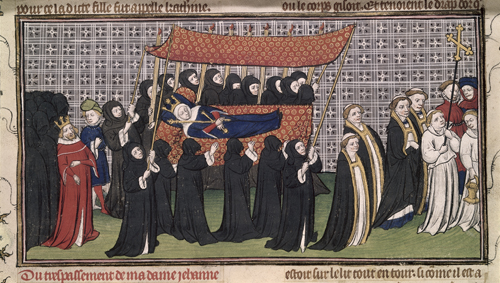
A bereft King Charles organized lavish funeral for his spouse. On the 14th of February 1379, a mourning procession, starting at the Hôtel Saint-Pol, transported the queen’s remains to the Cathedral of Notre-Dame of Paris for the funeral service. The following day, her body was delivered to the Basilica of Saint-Denis, where she was interred in a double tomb in the chapel of St. John the Baptist. The king’s body would join hers there in 1380. The queen’s heart was placed in the Church of the Cordeliers, her entrails in the church of the Celestins (the Couvent des Célestins) in Paris, perhaps because Charles V was especially devoted to the Celestine Order.
Like her husband, Jeanne was an avid reader and owned numerous books. They were all part of Charles V’s magnificent library inherited by his successor King Charles VI. Jeanne was remembered by her contemporaries as a wise and pious queen, but historical sources mention her mostly in relation to her husband Charles V, or to her son, Charles VI. She is usually presented as a discreet, educated, and modest wife and queen, one who was loved by the people and her husband, although recently her reputation was somewhat tainted by her alleged affair with Louis d’Harcourt, Viscount de Châtellerault, before the king himself dispelled the outrageous accusation.
All images are in the public domain.
Text © 2022 Olivia Longueville

